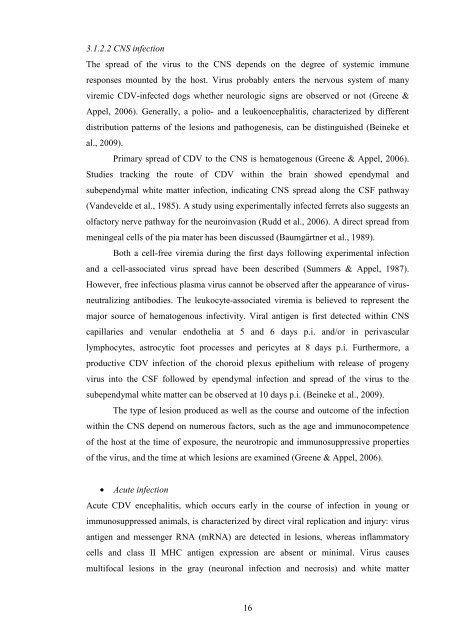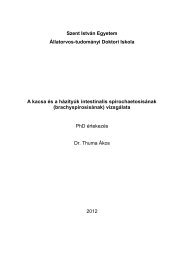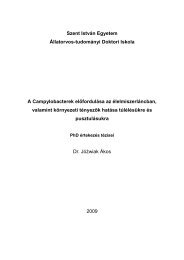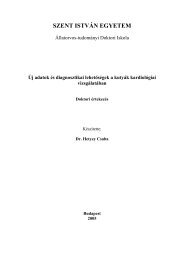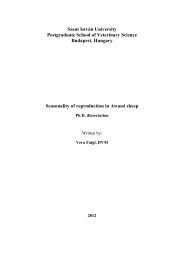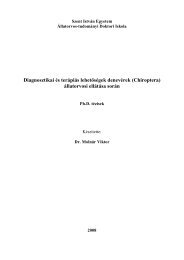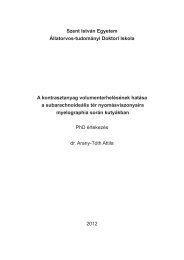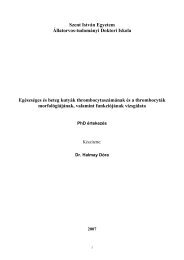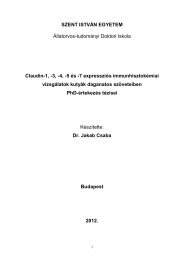PhD Thesis Demeter Zoltan
PhD Thesis Demeter Zoltan
PhD Thesis Demeter Zoltan
You also want an ePaper? Increase the reach of your titles
YUMPU automatically turns print PDFs into web optimized ePapers that Google loves.
3.1.2.2 CNS infection<br />
The spread of the virus to the CNS depends on the degree of systemic immune<br />
responses mounted by the host. Virus probably enters the nervous system of many<br />
viremic CDV-infected dogs whether neurologic signs are observed or not (Greene &<br />
Appel, 2006). Generally, a polio- and a leukoencephalitis, characterized by different<br />
distribution patterns of the lesions and pathogenesis, can be distinguished (Beineke et<br />
al., 2009).<br />
Primary spread of CDV to the CNS is hematogenous (Greene & Appel, 2006).<br />
Studies tracking the route of CDV within the brain showed ependymal and<br />
subependymal white matter infection, indicating CNS spread along the CSF pathway<br />
(Vandevelde et al., 1985). A study using experimentally infected ferrets also suggests an<br />
olfactory nerve pathway for the neuroinvasion (Rudd et al., 2006). A direct spread from<br />
meningeal cells of the pia mater has been discussed (Baumgärtner et al., 1989).<br />
Both a cell-free viremia during the first days following experimental infection<br />
and a cell-associated virus spread have been described (Summers & Appel, 1987).<br />
However, free infectious plasma virus cannot be observed after the appearance of virus-<br />
neutralizing antibodies. The leukocyte-associated viremia is believed to represent the<br />
major source of hematogenous infectivity. Viral antigen is first detected within CNS<br />
capillaries and venular endothelia at 5 and 6 days p.i. and/or in perivascular<br />
lymphocytes, astrocytic foot processes and pericytes at 8 days p.i. Furthermore, a<br />
productive CDV infection of the choroid plexus epithelium with release of progeny<br />
virus into the CSF followed by ependymal infection and spread of the virus to the<br />
subependymal white matter can be observed at 10 days p.i. (Beineke et al., 2009).<br />
The type of lesion produced as well as the course and outcome of the infection<br />
within the CNS depend on numerous factors, such as the age and immunocompetence<br />
of the host at the time of exposure, the neurotropic and immunosuppressive properties<br />
of the virus, and the time at which lesions are examined (Greene & Appel, 2006).<br />
• Acute infection<br />
Acute CDV encephalitis, which occurs early in the course of infection in young or<br />
immunosuppressed animals, is characterized by direct viral replication and injury: virus<br />
antigen and messenger RNA (mRNA) are detected in lesions, whereas inflammatory<br />
cells and class II MHC antigen expression are absent or minimal. Virus causes<br />
multifocal lesions in the gray (neuronal infection and necrosis) and white matter<br />
16


